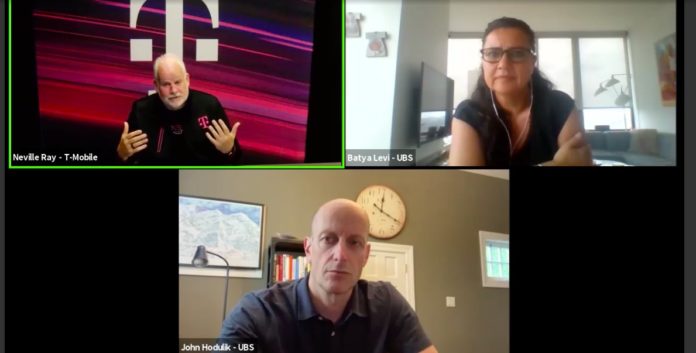‘We’ve come a hell of a long way’ since the Sprint merger last year, T-Mo’s Neville Ray says
T-Mobile US has grand ambitions for making in-roads in serving customers in rural America with both mobile and fixed wireless services, as the company’s President of Technology Neville Ray laid out at the UBS Future of 5G virtual event.
Ray emphasized that in terms of coverage, T-Mobile US already has a strong position, covering 295 million people and 1.6 million square miles. “That coverage story is super strong and it’s very relevant” for the carrier’s rural plans, he added. “When you think about what’s going to happen with 5G, the expansion and capabilities of 5G in rural America, the use cases that can be supported on that, [and] when you think about a voice layer on 5G, all of those things — it’s super important to have a very large … 5G layer across the nation.”
“We have huge ambitions to really grow this business in a traditional sense, in rural America,” Ray said. “We see a huge growth factor for this company, in small town and rural areas across the United States, where we under-index today. …It’s a big growth factor for us. It’s a super compelling one. And it also supports so many of the use cases that we’ve talked about in 5G over the years, especially, when it comes to IoT.”
He says that T-Mo is on track to reach 200 million people covered with its 2.5 GHz spectrum by the end of this year, after announcing in its last earnings update that it has 140 million POPs covered with the midband layer of its “layer cake”. Within its 2.5 GHz footprint, Ray added, T-Mobile US is seeing “speeds north of 300 Mbps, on average … the number is close to 330, 335 [Mbps].”
Those throughputs, he continued, are supported with an average of 60 to 80 megahertz of T-Mo’s hefty 2.5 GHz spectrum holdings, and he hopes to expand that yet this year to leverage 100 megahertz of its average 160 megahertz in spectrum depth. That would support speeds greater than 400 Mbps, according to Ray. He said that T-Mobile US already has some markets where it is using 100 megahertz of 2.5 GHz, although it’s not nationwide and varies by market. “As we move towards the end of the year, looking to get most of that 100 megahertz across the deployed base … the speeds are going to be super exciting,” he added. “Before our competition really gets started on [their] mid-band deployment, we’re going to have a powerhouse network out there with nationwide coverage, on a 100 megahertz of spectrum.”
He urged industry observers to not judge a carrier’s position by POPs alone, but also by the depth of their deployed available spectrum across markets — “because ultimately, that’s what dictates your speed, your capacity, and your performance.”
In terms of number of sites, he said that while Verizon is talking about having 7,000 to 8,000 midband sites deployed by the end of the year in preparation for the first tranche of C-Band spectrum being released, T-Mobile US has more than double that number deployed now to support its midband holdings.
“I’m driving as hard as I possibly can to deploy as much of that spectrum on 5G, as soon as I can over the next 18 to 36 months, before we can reach our crescendo on 5G mid-band spectrum,” he said, with the 2.5 GHz footprint eventually reaching perhaps as many as 50,000 or 60,000 sites across the U.S. and “hundreds of sites” being upgraded with 600 MHz and 2.5 GHz radios each week. “I have tens of thousands of people running across the U.S. deploying hardware, every day of the week,” he added, saying that “that pace and intensity … will be sustained fully as we move into ’23.”
“If you have to build out a C-Band network to match a 2.5 built mid-band network, you’re looking at probably up to a 50% increase in density,” he said. “Don’t get me wrong, we spent a lot of money on C-Band. We’ll be deploying that to supplement on top of a great 2.5 gigahertz layer. But it’s hard to believe that you’re going to be able to, with the density and the numbers that have been talked about by our competition … compete with the footprint and the breadth of coverage that T-Mobile is going to provide on 5G.”
In addition, he said, the full 160 megahertz of spectrum isn’t all needed for mobile wireless and will allow T-Mo to pursue its ambitions in home broadband and target about 7 to 8 million households — not a nationwide broadband service, but still something substantial.
“We have a path, from a network perspective, to generate that opportunity at very low incremental cost for the business,” he said, and added that “There’s a lot of interest from many areas of the country about the service that we’re bringing in early and initial feedback on the service is still early, but it’s very, very positive.”
The enormous capacity on the network is generating room for more growth and new opportunities, Ray said. “We have a lot of capacity. “Because of the 5G benefits and capacity, we can go and attack a home broadband market. We can go and attack [the] small towns’ rural geography, where over 130 million people live in the U.S. Those are real, tangible opportunities for us, with [the] powerhouse network that we have.”

